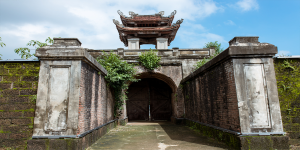
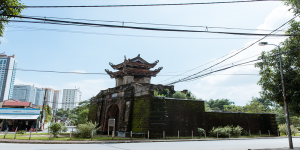

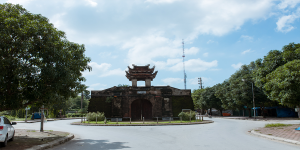
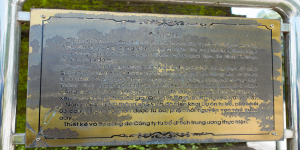
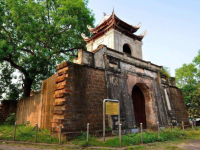
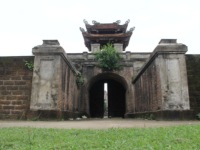
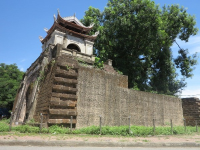
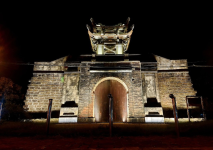
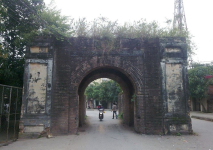
Camera tour
Price: Free
Time to visit a place: 120 phút
Open Time: 7:00 AM - Close Time: 6:00 PM
Address: Cua Nam Sub-district, Vinh City, Nghe An Province
VINH ANCIENT CITADEL
Located in the center of Vinh city - Political economic center of Nghe An province, Vinh Ancient Citadel (also known as Nghe An citadel) was started by King Gia Long in 1804 in 02 communes Yen Truong and Vinh Yen in Yen Truong canton, Chan Loc district (now under the area of 3 wards: Quang Trung, Cua Nam and Doi Cung). At first, the citadel was built of earth, in 1831, King Minh Mang rebuilt it on a large scale, designed in the style of "vô băng" (can't be robbed or can't lose), a type of stronghold popular citadel in Europe but still has traditional elements of Asian architecture.
The location of the citadel was built by the forefathers who applied Eastern feng shui theory, with the flat bright land being the Con Moc river, 9 twists and turns, the left (Southeast) has the Hong Linh range - associated with the legend of 100 phoenix birds as Thanh Long, on the right (west) is a majestic Thien Nhan range - associated with the name of Lam Son insurgent army as Bach Ho. In the distance it is the Lam Thanh mountain range with 3 mountains: Trieu Khau, Phuong Hoang, Nghia Liet as a fulcrum.
To build Vinh Ancient Citadel, the Nguyen Dynasty mobilized 1,000 soldiers from Thanh Hoa and 4,000 soldiers from Nghe An. By the time of Tu Duc, when upgrading the citadel, 8,599 scallop stones had to be taken from Dien Chau and laterite from Nam Dan, 4,848 kgs of lime, 155 kgs of molasses, with a total cost of 3,688 quan tiền eefan ancient currency unit of Vietnam) – a huge amount at that time. The citadel had a hexagonal structure with an area of 420,000 m2, a circumference of 2,520 m. On the surface of the citadel, there are military buildings. The wall is 5.08 m high, surrounded by a moat 3.2 m deep and 28 m wide. Two banks of the moat were grafted with stones, in the moat, people planted lotus flowers to pay tribute to the court. The citadel has 3 gates: Tien Gate in the south - for the king to reside in, the mandarins in the six royal ministries and the Governor-General to enter and exit. The left gate is in the east, the right gate is in the west. To go through the gates, it has to cross the bridge. The bridge is built in the style of a rolling arch, the bridge is wide so that boats can pass easily.
Inside the largest building is the palace, the East is the Governor's palace; In the south are the palaces of Bố chánh, Án sát, Lãnh binh, Đốc học; In the north there are barracks and prisons. Later, the West had house of the head of French barracks. The entire citadel is equipped with 65 cannons, 47 cannons are placed at the guard posts, the rest are gathered in Kinh's residence and the Governor's palace..
Vinh citadel was born with the purpose of creating a political, military and cultural center of Nghe An province, but the feudal system of the Nguyen Dynasty was on the way of decline, so it had not yet destroyed the active role as intended design. Even, it soon became a center against patriotic movements, was a testimony of a tragic and heroic period of people in Nghe An province.
In 1818, in Vinh citadel, there was an attack by Hau Tao, which scared the rulers. In 1958, before the invasion of the French colonialists, the citadel was fortified by Governor General Vo Trong Binh, ready to fight against the invaders, but the cowardly Nguyen court sent Vo Trong Binh to another place, making Vinh citadel easily fell into the hands of the French colonialists.
This is also the place to witness the event that Mrs. Nguyen Thi Thanh (President Ho Chi Minh's sister) organized to steal guns from the enemy to supply the insurgents of Doi Quyen and Doi Phan. The case was exposed, she was arrested and taken to Vinh Prison. The trial on June 4, 1918 sentenced her to being beaten with 100 sticks and imprisonment for 9 years. Following the exciting period of the revolutionary climax of 1930 - 1931, Vinh Ancient Citadel became a place to witness the fierce struggles of the people of Nghe An, as the foundation of a heroic Nghe Tinh Soviet.
In 1941, Vinh ancient citadel witnessed again the sacrifice of Doi Cung and his associates. His grave still lies quietly and majestically under the green trees in the ancient citadel. On August 20, 1945, with a heroic spirit, our army and people attacked Vinh ancient citadel - the den of feudal colonization on the land of Nghe An, contributing to the creation of the great song of August 1945. This is also the place where President Ho Chi Minh worked with the Provincial Party Committee and spoke to the Nghe An People's Deputies Conference during his two visits to his hometown (1957 and 1961).
Through the process of history, the rigors of time and the destruction of war, Vinh Ancient Citadel is no longer intact, only 3 towering gates remain between the roads leading to the inner city. In 1998, the relic was classified as a National Historic Site by Ministry of Culture and Information in Decision No. 95 – QD/BVHTT dated January 24, 1998.
Currently, Vinh Ancient Citadel is being invested by all levels and sectors to match its historical position and become the city's highlight in tourism development, attracting domestic and foreign tourists.
Distance: 360 m
Distance: 540 m
Distance: 550 m
Distance: 1.43 km
Distance: 1.56 km
Distance: 1.86 km
Distance: 1.88 km
Distance: 1.90 km
Distance: 1.91 km
Distance: 710 m
Distance: 850 m
Distance: 1.19 km
Distance: 1.70 km
Distance: 1.74 km
Distance: 1.77 km
Distance: 1.82 km
Distance: 1.87 km
Distance: 1.90 km
Distance: 1.97 km
Distance: 2.03 km
Distance: 2.06 km
Distance: 2.10 km
Distance: 2.16 km
Distance: 2.17 km
Distance: 2.20 km
Distance: 2.27 km
Distance: 2.29 km
Distance: 0 m
Distance: 180 m
Distance: 500 m
Distance: 610 m
Distance: 620 m
Distance: 710 m
Distance: 720 m
Distance: 820 m
Distance: 1.48 km
Distance: 1.62 km
Distance: 1.63 km
Distance: 1.68 km
Distance: 1.72 km
Distance: 1.81 km
Distance: 1.94 km
Distance: 2.02 km
Distance: 2.05 km
Distance: 2.05 km
Distance: 390 m
Distance: 500 m
Distance: 630 m
Distance: 960 m
Distance: 960 m
Distance: 1.12 km
Distance: 1.16 km
Distance: 1.53 km
Distance: 1.63 km
Distance: 1.83 km
Distance: 1.87 km
Distance: 1.90 km
Distance: 1.93 km
Distance: 2.02 km
Distance: 2.04 km
Distance: 2.04 km
Distance: 2.11 km


